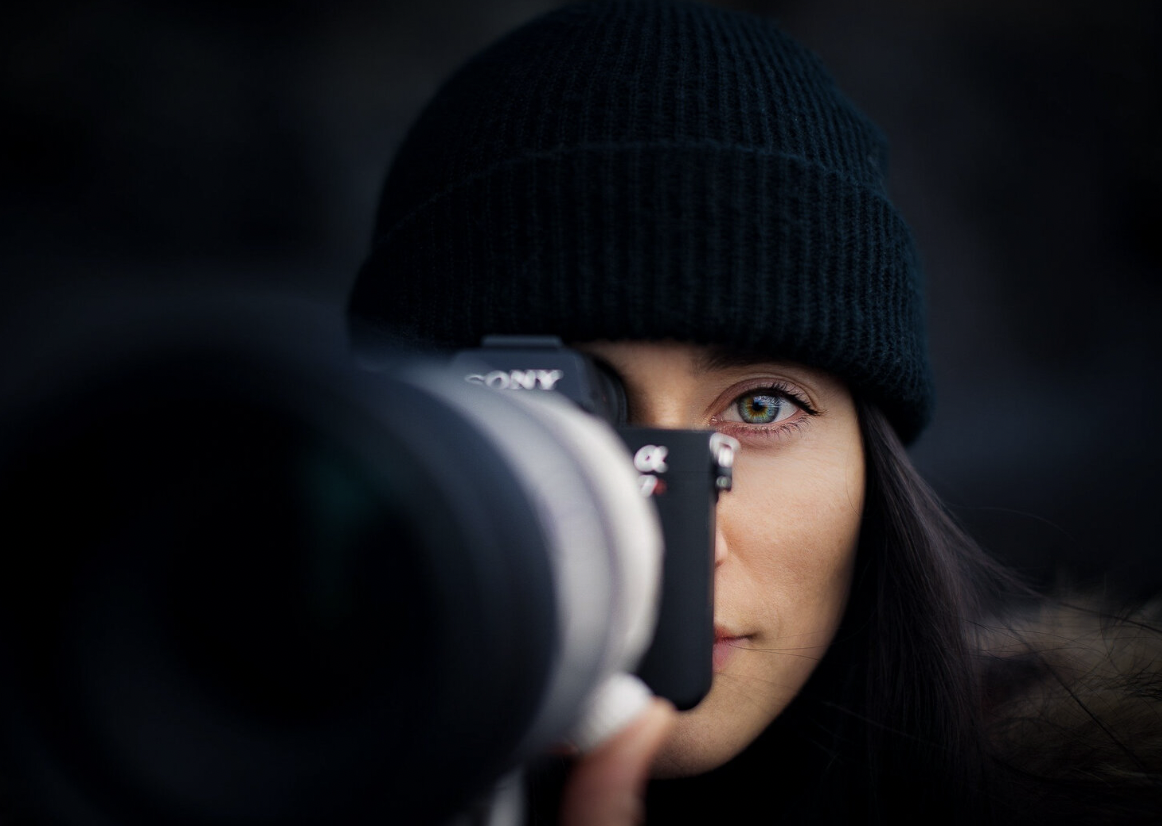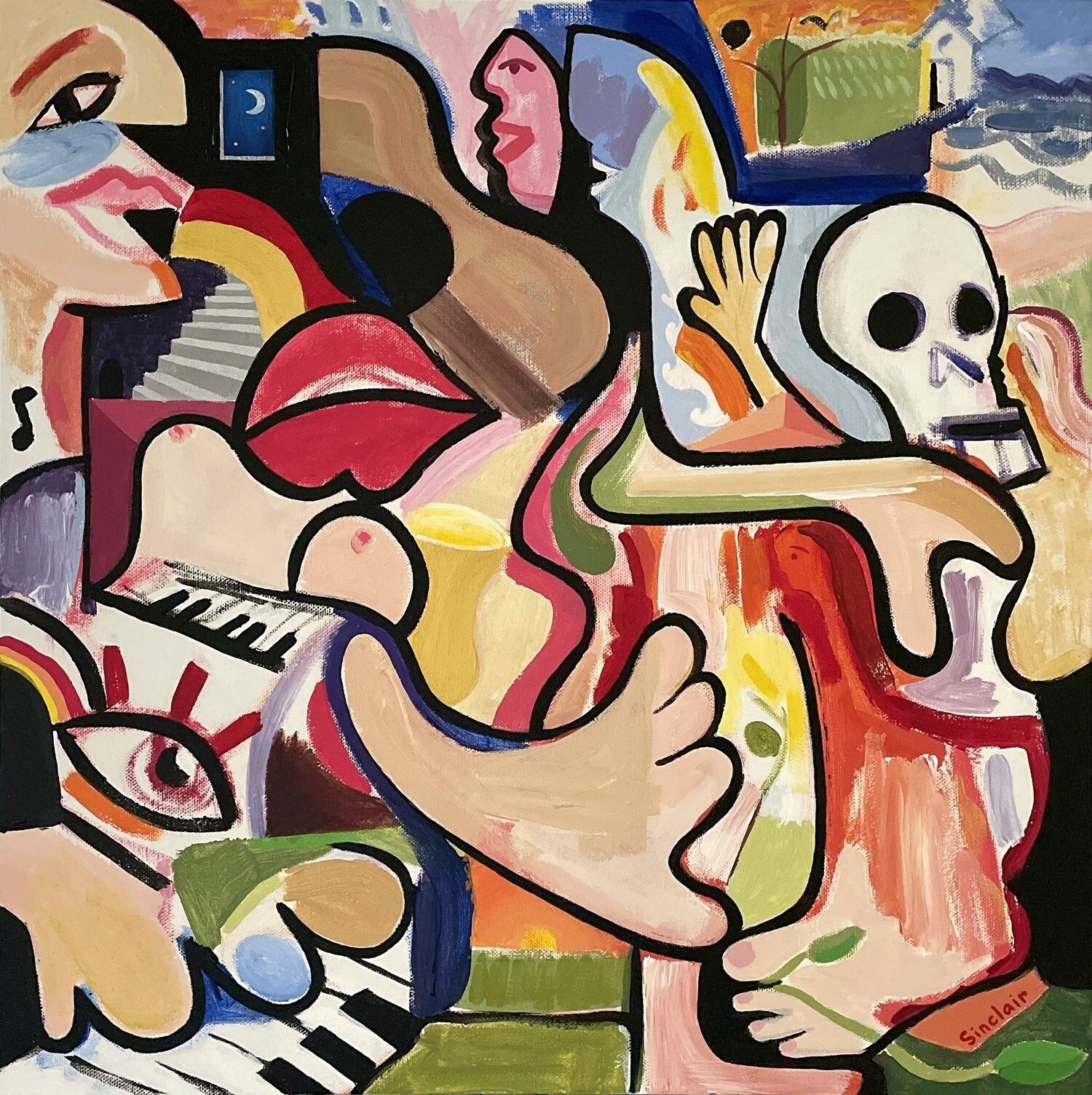About the artist: Cath Simard
Cath Simard is a Canadian-born fine art photographer and digital artist whose ethereal, otherworldly landscapes have made her a defining figure in the world of NFT photography. Her weork, a fusion of imagination and reality, is known for its dreamlike depictions of cold, blue-hued mountain scenes, often captured under night skies. Collectors are drawn to the singularity of her vision, a product of her deep connection to nature and her relentless pursuit of unique perspectives. With a commitment to crafting landscapes that transcend the ordinary, Simard has become one of the most influential voices in the intersection of fine art and NFTs, shifting the paradigm of photography in the digital age.
Simard’s artistic process is a rigorous and deeply immersive experience. She treks vast distances—up to 250 kilometers in a single journey—and climbs to elevations as high as 5,900 meters to capture the raw elements of her compositions. Her approach is akin to a painter collecting pigments; she views the landscape as a puzzle, gathering fragments of reality from multiple visits, different times of day, or even separate locations, which she later combines into a singular, cohesive image. Informed by the patience of traditional fine art, she may return from days of hiking without a single photo, waiting for the precise conditions that match her vision. Once captured, her images often sit for months or even years before she begins editing, allowing her to revisit the feelings and experiences of the landscape with fresh eyes, transforming them into highly refined, surreal compositions.Simard’s limited output—typically 5-7 images per year—reflects the painstaking nature of her work. Her pieces have achieved critical acclaim not only for their technical mastery but also for their conceptual depth, exploring themes of isolation, transformation, and the sublime in nature.
Outside of her fine art practice, Simard has collaborated with prominent brands like Sony Alpha, The North Face, Emirates Airline, National Geographic, and Art of Visuals, creating visually captivating campaigns that highlight her unique ability to merge nature and digital artistry. Furthermore, her work has been featured in renowned publications, including Outdoor Photography Magazine and Open Skies Magazine to name a few.
Cath Simard is currently based in Canmore, Alberta, where she continues to push the boundaries of photography and digital art, blending physical endurance, technical precision, and digital innovation into her evolving practice.
The interview:
Paloma: Your work is known for blending reality with imagination, creating surreal and ethereal landscapes. How do you conceptualize these visions, and what role does the physical landscape play in shaping your final images?
Cath: My process of conceptualizing my work is deeply personal and starts long before I step into the landscape. It begins with an idea or a feeling, something that stirs inside of me, often triggered by an emotional experience or a place I desire to explore. That feeling drives me to search for a physical place that aligns with it. For example, if I desire to challenge myself physically and mentally, I might pick a place that brings this opportunity like Patagonia or Peru. Through thorough research (trip reports, books, etc.), I will then start to imagine and pre-visualize the final artwork. In the field, this helps me plan and focus on capturing all the elements I need to create the artwork.
The physical landscape plays a crucial role, but not in a literal sense. I see landscapes as puzzle pieces—fragments of reality that I can manipulate to evoke a particular emotion or tell a story. Oftentimes, the final artwork will be a reflection of both the internal and external journey while in the mountains. But I don’t feel confined by what I see; very rarely it will be an accurate representation of reality. My mind often fills in the gaps, and that’s where the imagination takes over. The landscape is the canvas, the experience is the brush strokes and my imagination is the paint. The final image is a blend of what I saw, what I felt, and what I imagined could exist. I want people to question whether the scene is real, to feel that tension between reality and fantasy, because that’s where I believe the magic lies.
Paloma: Can you walk us through your creative process, from scouting a location to the final edit? How do you balance patience with creative spontaneity?
Cath:
Planning and Research: My journey often begins with extensive research both online and in the field. I often use Google earth and trip reports/blog entrees to get a better idea of the location when possible. I also use different apps like Photopills to know the direction of the light, the milky way as well as the moon cycle. Preparation and planning can truly help me materialize my creative vision and achieve better results. I can spend weeks, months or years researching and planning but also scouting and going back to a specific location until I’m able to capture all the elements I need to create the artwork I have envisioned.

Shooting - When it comes to capturing the images, I often embark on solo expeditions. This allows me to fully disconnect with the external world and focus on my own emotions and ideas. The experience is about immersing myself in the landscape, free of distractions, and executing the plan I have for this location, capturing the landscape in multiple pieces. However, I also try to attune myself to reality and pay attention to the unplanned opportunities the landscape offers me. While in the field, I observe the light, the textures, the movements, and the emotions that arise within me. Finally, I always make sure to experiment and capture elements that might not work out or make sense in the moment, but that might in the future.

Editing - Once I return home, the editing process begins, and this is where patience truly comes into play.
For me, editing is not just a technical task; it’s a deeply emotional journey. I reflect on the feelings I experienced during my time in the landscape and how I want to communicate those emotions through my work. - Cath
For instance, while editing ‘’Jardin Secret’’, I devoted over 150 hours to blending 21 raw images. This was challenging technically, but it also allowed me to explore themes of connection, love, and self-acceptance. The editing phase requires me to sit with my emotions and allow them to guide my creative choices. I take this as an opportunity to present to the world the depths of who I truly am, both literally and metaphorically.
Jardin, 2022
Paloma: You often revisit the same location multiple times before capturing the elements that form a single image. How does your relationship with the landscape evolve through this process?
Cath: My relationship with the landscape evolves significantly each time I revisit a location. Each trip adds layers to my understanding and connection with the space, transforming it into a living entity that resonates with my emotions and experiences.
When I first arrive at a location, I’m often overwhelmed by its beauty and complexity. I feel a rush of inspiration as I explore and experiment, capturing images that speak to me in the moment. However, as I return, I start to see beyond the surface. I become more attuned to the subtleties of the environment. I also pay attention to how I myself changed as a human and how this influences my experience.
With every new visit- given that the previous ones weren't satisfactory - I push myself to shift my perspective towards new angles and elements. I force myself to evolve in a way, staying away from the compositions that did not inspire me previously. It’s almost as if I’m entering a dialogue with the landscape, teaching me how to evolve.
Paloma: Your work includes striking color palettes that create dramatic contrasts and emphasize the unique qualities of the landscapes that you are capturing. Can you speak a little more about how you approach color in your work?
Cath: Blue is a central theme in my work, embodying a sense of tranquility, introspection, and depth. I often capture the landscape when it is bathed in blue tones, which occurs during twilight, blue hour and the night.
Nuit Blanche, 2022
This color blue has long been a part of my creative journey, dating back to my work in fashion styling, where blue was frequently featured. When I started landscape photography in 2016, I naturally gravitated toward it, though I didn’t initially understand why. As I built my portfolio, I started questioning the recurring presence of blue in my art, leading me to research its deeper effects.
Scientifically, blue occupies a unique space in the spectrum, with wavelengths that are perceived by the human eye as cool, calming, and distant. This color's ability to lower heart rates and reduce anxiety makes it a powerful psychological tool. As someone who struggles with anxiety, I’m drawn to the soothing qualities of blue, which mirror the calm I feel when I’m in nature.
- Cath
The color palettes I choose are often rooted in analogous, complementary, or diadic color harmonies. I focus on using 2-3 tones in an image, which I believe helps streamline its visual impact.
Blue frequently emerges as a dominant primary color in my work. I enjoy pairing it with bold hues such as red, yellow, or orange to guide the viewer’s eye toward specific elements. For instance, I often use myself as the subject in my pieces, intentionally wearing red garments to emphasize the contrast between the expansive, cold landscape and my presence, reinforcing the feelings of solitude and serenity. Yet, blue possesses an inherent depth and darkness. It can evoke the threat of the unknown, underscore unwelcoming environments, and highlight the vulnerability of a human subject facing the forces of nature.
The high-contrast scenes I create through specifically targeted highlights and shadows emphasize the perceived experience and add impact. I believe they also reflect my highly contrasting personality, serving as a visual metaphor of how I view and experience life myself. During these expeditions, I encounter a mix of conflicting emotions: freedom and loneliness, fear and confidence, anxiety and peacefulness. I feel these opposing feelings manifest in my high-contrast style, a consistent element throughout my work.
Paloma: Much of your work is created in isolation, often during long treks in remote locations. How does this solitude influence your creativity? Do you feel it helps you connect more deeply with your subject matter?
Cath: Solitude is an essential part of my creative process. It’s in these profound moments of isolation that I can truly connect with the landscape around me on on a deeper level. I can start to see and feel things that might otherwise go unnoticed.
“The solitude strips away all distractions, leaving me with nothing but my thoughts and the natural world around me. It truly forces me to be present. This deep sense of immersion helps me tap into a creative flow state, where all my senses are heightened.” - Cath
I become deeply attuned to my surroundings, noticing subtle details and unique compositions that might otherwise go unnoticed.
Isolation brings with it a certain vulnerability. Being alone in vast, often unforgiving environments can feel both exhilarating and overwhelming. It’s a humbling reminder of my smallness in the grand scheme of nature. Yet, that very vulnerability fuels my creativity, pushing me to confront my fears and doubts, and channel those emotions into my work.
Solitude has taught me patience—both in my creative process and in life. There’s a sense of surrender that comes from being alone in the elements, accepting that I can’t control them and must simply wait and be prepared. That waiting, however, creates a space where creativity can emerge organically, without force. In those moments, I’m not just taking photos; I’m fully absorbing the experience, allowing the landscape to seep into me.
This connection, forged through solitude, shapes every image I create. - Cath

Being alone in nature also strips away everything external and forces you to confront yourself. When you’re deep in the wilderness, there’s nowhere to hide from your own thoughts. In those moments, everything slows down, and the silence can be almost deafening, it pushes you to face your own emotions, memories, and fears that you might usually suppress or avoid. In my opinion, it is one of the best ways to do introspection and grow, and I try to reflect this in the work I create.
In the end, solitude isn’t just a part of my process; it’s where my creativity thrives.
Paloma: Lighting plays a pivotal role in your work and has become a defining characteristic of your style, beyond just your color palette and subject matter. Your use of light sets your pieces apart in a striking way. Can you walk me through your process of capturing light and timing it perfectly within your images?

Cath: Capturing light is universal amongst photographers. My process involves restricting the times where I capture it between sunset and sunrise. This is where the light is the most interesting to me. However for my work, the magic happens during the editing process, while combining all the elements together. During this phase, I combine different types of lighting that could not necessarily exist or happen in nature, allowing me to create this surreal, characteristic look. For example, I will often combine a foreground shot during blue hour with a sky shot during the night. To sum up, the combination of different types of lighting in my work is as important as capturing the right light.
Paloma: What other artists or influences are you inspired by if any?
Summer-in-Lauterbrunne, Max Rive
Cath:
My two main inspirations in photography have always been Max Rive and Benjamin Everett. Max’s dedication to exploring remote areas and capturing the grand scale of landscapes resonates deeply with me. His meticulous scouting leads to unique and original compositions that are rarely seen, pushing the boundaries of what’s achievable in landscape photography. Originality is something I prioritize in my own work, and Max’s example motivates me to push further. His dramatic use of light and high-contrast editing imbue his images with a surreal quality that evokes powerful emotions in the viewer. Over the years, he has developed a distinctive signature style that inspires countless photographers around the globe. He has truly been an incredible source of inspiration for me.
Conversely, Benjamin Everett’s work appeals to my more imaginative side. His composite pieces, which blur the lines between reality and imagination, have influenced me to experiment with those themes in my photography. Studying his work opened up a new perspective on what is possible in landscape photography. His intricate layering and seamless compositing techniques have encouraged me to approach my art with a similar mindset, allowing me to transcend traditional landscape photography rules and push into new creative territories.

Baker Snow Lines, North Cascades, 2017 by Benjamin Everett
Paloma: You’ve said that only a small part of your personality is visible when you’re in urban spaces. How do you feel your art reveals aspects of your personality that might not be apparent otherwise?
Cath: When I’m in urban spaces, there’s a certain part of me that feels muted or restrained, like I’m only showing a small fraction of who I truly am. In these environments, there’s so much external noise, expectations, social structures, and distractions—making it harder to express that deeper, more authentic side of myself. But when I’m alone with nature, the social anxiety and layers start to peel away, and I can tap into parts of my personality that remain hidden in everyday life.
My art becomes the conduit for revealing those hidden aspects. The images I create are reflections of the way I experience the world on a much deeper level—my vulnerabilities, my introspective side, my love for both freedom and solitude. These emotions and thoughts don’t always translate in the way I interact with others in person, but in my work, they come alive. The harsh beauty of the landscapes I explore, the dramatic contrasts, the bold colors—they mirror the intensity I feel inside. For example, in the cold blues and sharp reds, there’s the tension of contrasting emotions I live with: tranquility mixed with restlessness, calmness set against obsession.
See more of Cath Simard’s work on SuperRare here





